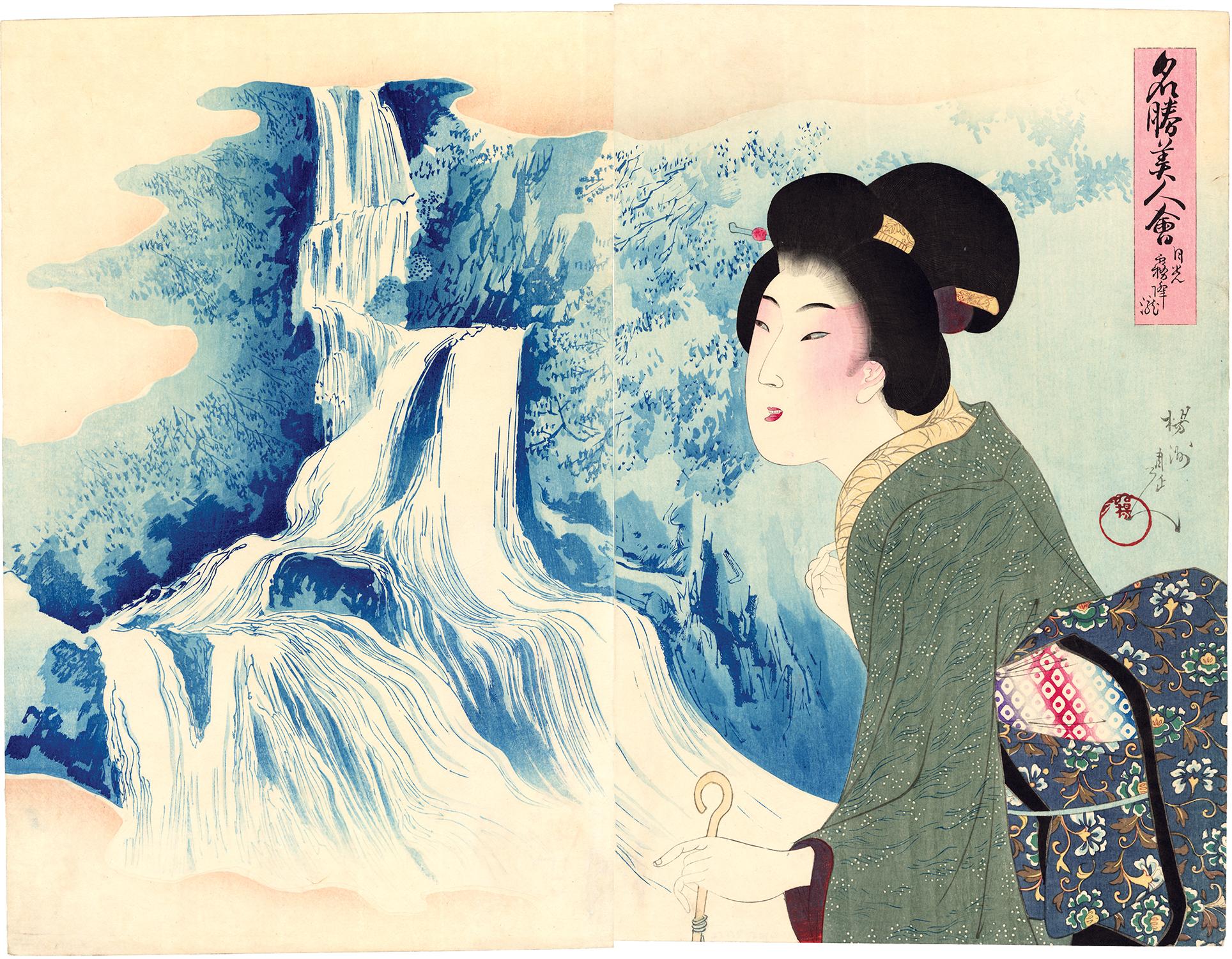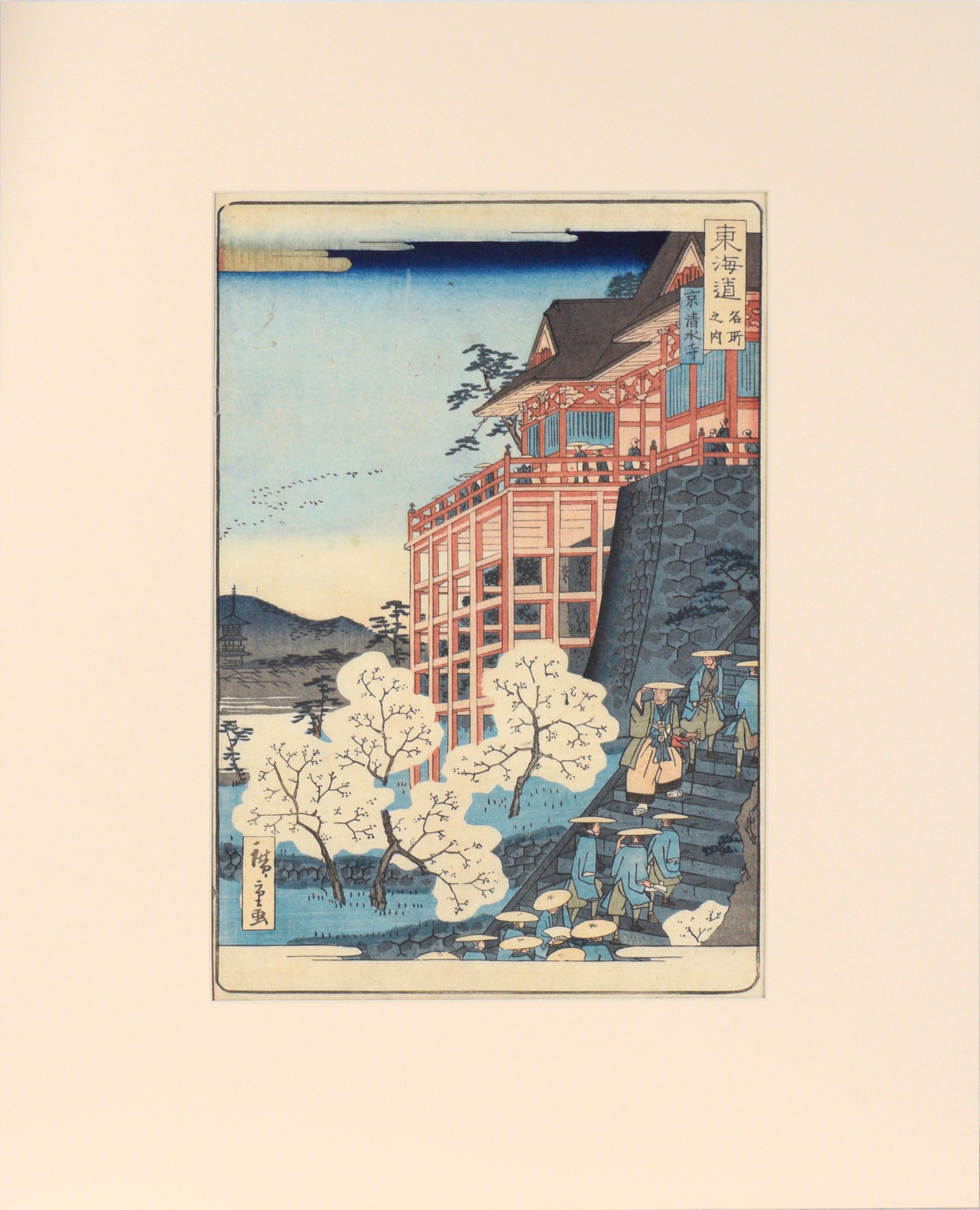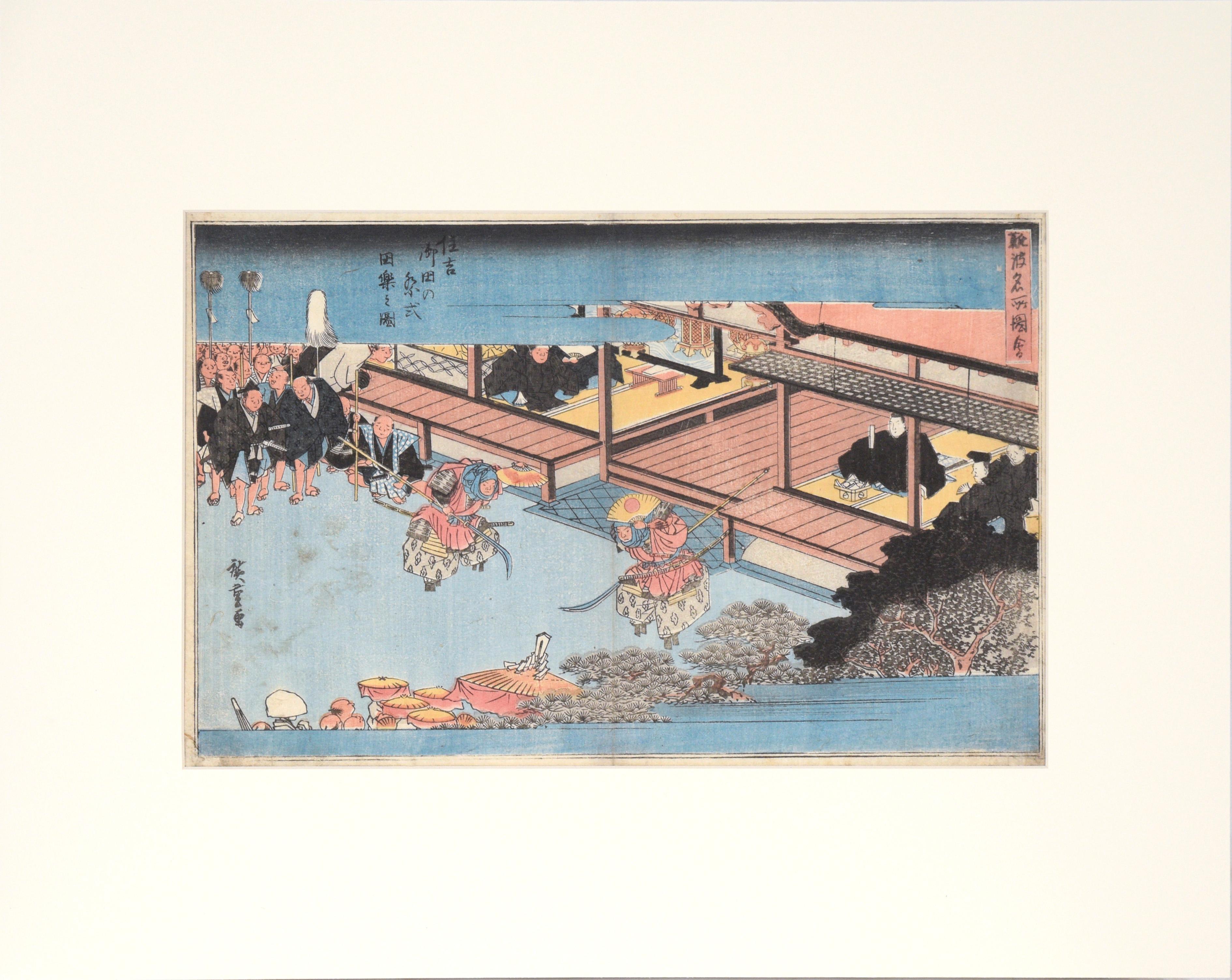Items Similar to Beauties on the Beach with view of Mount Fuji
Want more images or videos?
Request additional images or videos from the seller
Yoshu ChikanobuBeauties on the Beach with view of Mount Fuji
About the Item
Shichirigahama, Sagami Province. A beauty in the foreground waves to her young companions, who run towards her on the beach. The beauty at left wears a western-style golden ring. We see a woman in the middle distance gathering seaweed, a village nestled in a cove, and Mount Fuji rising above the entire scene, surrounded by orange mist. Perfect image for the beach house or bedroom. Original Japanese color woodblock print from the series "Beaties and Famous Views" (Meisho bijin-e). Sigend: Yoshu Chikanobu.
- Creator:Yoshu Chikanobu (1838 - 1912, Japanese)
- Dimensions:Height: 14.38 in (36.5 cm)Width: 18.9 in (48 cm)
- Medium:
- Movement & Style:
- Period:
- Condition:Lightly backed.
- Gallery Location:Burbank, CA
- Reference Number:
About the Seller
5.0
Recognized Seller
These prestigious sellers are industry leaders and represent the highest echelon for item quality and design.
Established in 1975
1stDibs seller since 2015
57 sales on 1stDibs
Associations
International Fine Print Dealers Association
- ShippingRetrieving quote...Ships From: Burbank, CA
- Return PolicyA return for this item may be initiated within 14 days of delivery.
More From This SellerView All
- Japanese Beauty Admiring Kirifuri WaterfallBy Yoshu ChikanobuLocated in Burbank, CAA beauty turns to admire the Kirifuri Waterfall in Nikko Province. She holds the handle of an umbrella and wears fashionable clothing that is beautifully printed. This series pairs f...Category
1890s Edo Landscape Prints
MaterialsMulberry Paper, Handmade Paper, Woodcut
- Ôkubo Hikozaemon Protects the Hidden Shogun TriptychBy Taiso YoshitoshiLocated in Burbank, CA“War Chronicles of Osaka” (Osaka gunki no uchi). Okubo Hikozaemon, raising his sword, protects the hidden Tokugawa shogun from the spear of Gorô Matabei Mototsugu in a moonlit fores...Category
1880s Other Art Style Figurative Prints
MaterialsWoodcut, Mulberry Paper
- Itsukushima Moon--A Muro CourtesanBy Taiso YoshitoshiLocated in Burbank, CAA courtesan in Heian period style looks over the prow of her watercraft, looking ahead through the famous torii of Miyajima (Itsukushima) Shrine. She will be dancing in the ceremonies of the annual festival held in Itsukushima in the sixth month of the lunar calendar. Note the ukiyoe style of the beauty and the water, and the Shijo style of the rendering of the torii and the shore. Her enormous traveling hat and veil are placed beside her. From the series "One Hundred Famous Views of the Moon...Category
1880s Other Art Style Figurative Prints
MaterialsWoodcut, Mulberry Paper
- Umewaka Shrine in the RainBy Kobayashi KiyochikaLocated in Burbank, CAUmewaka Shrine, from an untitled series of prints depicting Tokyo. A woman braces her umbrella against the rain and a man waits out the storm next to his jinriksha in this view of th...Category
1870s Edo Landscape Prints
MaterialsMulberry Paper, Handmade Paper, Woodcut
- Chiyogaike Pond, Meguro from 100 Famous Views of EdoBy Utagawa Hiroshige (Ando Hiroshige)Located in Burbank, CAA cascading waterfall fills Chiyo’s Pond, named after an ancient samurai’s wife. Cherry trees in full bloom line the banks of the pond. The reflections of the trees in the pond are a notable feature, as Hiroshige did not use reflections in very many of his prints, as it was something of an exotic import. From the series One Hundred Famous Views of Edo...Category
1850s Edo Landscape Prints
MaterialsWoodcut, Mulberry Paper
- Japanese Beauties Enjoy a Full MoonBy Utagawa Kunisada (Toyokuni III)Located in Burbank, CA"Sun, Moon and Stars". Three beauties enjoy a full moon on the veranda of a teahouse or restuarant. The woman on the left kneels and adjusts her lavishly printed kimono. The beauty in the center has her hair down, and behind her is a screen against which shadows are beautifully silhouetted, which adds an air of mystery. The seated woman on the right is perhaps a geisha, as we see a shamisen lying next to her. Before her is a tray with an assortment of foods. One may surmise that the beauties are being compared to the sun, the moon, and the stars. On the left we glimpse a full moon shining over the peaceful bay, and boats at harbor. Original first edition Japanese color woodblock print triptych...Category
1840s Edo Figurative Prints
MaterialsWoodcut, Mulberry Paper
You May Also Like
- "Various Himochi" Wagashi Festival Japanese Woodblock Print by Utagawa ToyokuniLocated in Soquel, CA"Various Himochi" Wagashi Festival Japanese Woodblock Print by Utagawa Toyokuni Rare oversized early 19th century 5-tiered woodblock by Utagawa Ichiyosai Toyokuni, (Japan, 1769-1825), a Japanese lord and wife oversee a sekku festival of food, music, and dolls or toys. '"oshi" is the first day of “Mi (Snake)” in the third month of the lunar calendar. This day, known in modern Japan as the Girls' Festival, originated in China as a form of purification ceremony in which water and drinking peach blossom wine were used to drive away evil. Many kinds of hishi-mochi appear in this picture of hina ningyo (dolls associated with Hinamatsuri, or the Girl’s Day) from Omochae. The custom of eating special dishes at events throughout the year and at milestones in people's lives has existed since ancient times. This paragraph specifically focuses on the annual event called sekku, and life events that involve eating sweets. Joshi is the first day of “Mi (Snake)” in the third month of the lunar calendar. This day, known in modern Japan as the Girls' Festival, originated in China as a form of purification ceremony in which water and drinking peach blossom wine were used to drive away evil. According to the Keiso saijiki, in ancient China, on the third day of the third lunar month, people ate “ryuzetsuhan,” which is the juice of gogyo (Jersey cudweed) mixed with rice flour and nectar. In Japan, there is a record in the Heian period history book Nihon Montoku tenno jitsuroku [839-5] that it was an annual event to make kusamochi using gogyo on the third day of the third month of the lunar calendar, which may have been influenced by Chinese customs. The tradition of eating kusamochi on the third day of the third month of the lunar calendar continued after that. By the Edo period, however, hishimochi had come to be used as a sweet to serve on the third day of the third month. A picture of a hishimochi is included in the Morisada manko , which we mentioned in Part 1. According to it, hishimochi in the Edo period were often three layers of green-white-green instead of the now common red-white-green. However, it is possible to see from our collection that not all hishimochi were made in this way. Omochae published in 1857, is a good example. Omochae is a type of ukiyoe print...Category
1820s Edo Figurative Prints
MaterialsInk, Rice Paper, Woodcut
- Narihira's Journey to the East - Japanese Woodblock on Paper by Kikugawa EizanBy Kikugawa EizanLocated in Soquel, CANarihira's Journey to the East - Japanese Woodblock on Paper Original 19th century Japanese woodcut print depicting Narihira's journey to the East by a follower of Utamaru, Kikugaw...Category
Early 19th Century Edo Figurative Prints
MaterialsWoodcut, Rice Paper, Ink
- Kiyomizu Temple, Scenes of Famous Places along Tôkaidô Road - Woodblock on PaperBy Utagawa Hiroshige IILocated in Soquel, CAKiyomizu Temple, Scenes of Famous Places along Tôkaidô Road - Woodblock on Paper Full Title: Kyoto: Kiyomizu Temple (Kyô Kiyomizudera), from the series Scenes of Famous Places along...Category
1860s Edo Landscape Prints
MaterialsInk, Rice Paper, Woodcut
- The Battle of Dan-no-ura in Yashima, Nagato Province in the First Year .....By Utagawa YoshitoraLocated in Middletown, NYThe Battle of Dan-no-ura in Yashima, Nagato Province in the First Year of the Bunji Era (1185) Tokyo c. 1830 Woodblock print (nishiki-e) with ink and hand-coloring in watercolor on handmade mulberry paper, 14 7/16 x 9 15/16 inches (367 x 252 mm), ōban tate-e, the full sheet. In good condition with some handling creases. Colors are fresh and extremely vibrant. The right panel from the triptych by Yoshitora depicting one of Japan's most storied naval battles. An impression of this work may be found in the permanent collection of the Honolulu Museum of Art. The great naval battle of Dan-no-ura in 1185 was the final climax in a long series of bitter wars between two powerful families in feudal Japan...Category
Early 19th Century Edo Figurative Prints
MaterialsHandmade Paper, Watercolor, Woodcut
- Sumiyoshi: Dengaku dance performed during an Onda ceremony - Woodblock PrintBy Utagawa HiroshigeLocated in Soquel, CASumiyoshi: Dengaku dance performed during an Onda ceremony - Woodblock Print Bright woodblock print by Utagawa Hiroshige (Japanese, 1797-1858). In this scene, two dancers with swords and fans are facing each other, in the center of a courtyard. There are spectators surrounding them, including nobles in black clothing on a balcony. Presented in a new off-white mat with foamcore backing. Mat size: 16"H x 20"W Paper size: 9.63"H x 14.5W" Utagawa Hiroshige (1797-1858, sometimes called Ando Hiroshige) was the second of the two great masters of the Japanese landscape woodblock print...Category
1830s Edo Figurative Prints
MaterialsInk, Rice Paper, Woodcut
- Mitate of a Daimyo's Procession Crossing Ryogoku Bridge - Woodblock PrintBy Keisai EisenLocated in Soquel, CAMitate of a Daimyo's Procession Crossing Ryogoku Bridge - Woodblock Print Woodblock print of a procession by Keisai Eisen (Japanese, 1790–1848). Terrific triptych of a procession of...Category
Early 19th Century Edo Figurative Prints
MaterialsWoodcut, Rice Paper, Ink
Recently Viewed
View AllMore Ways To Browse
Antique Beauty
Color Woodblock Prints
Beach Style Bedrooms
Japanese Color Woodblock Print
Japanese Woodblock Beauties
Beach Ring
Woodcut Mount
Woodblock Print Of A Beauty
Famous Japanese Woodblock Prints
Japanese Wave Print
Woodblock Beauty
Woodblock Woman
Cove House
Wearable Art Ring
Chikanobu Woodblock Print
Seaweed Ring
Rowboat Print
Huchet Lithograph





